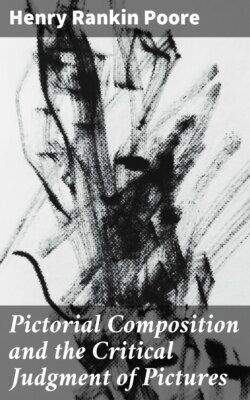Читать книгу Pictorial Composition and the Critical Judgment of Pictures - Henry Rankin Poore - Страница 11
На сайте Литреса книга снята с продажи.
THE NATURAL AXIS
ОглавлениеTable of Contents
In varying degrees pictures express what may be termed a natural axis, on which their components arrange themselves in balanced composition. This axis is the visible or imaginary line which the eye accepts connecting the two most prominent measures or such a line which first arrests the attention. If there be but one figure, group or measure, and there be an opening or point of attraction through the background diverting the vision from such to it, then this line of direction becomes the axis. The axis does not merely connect two points within the picture, but pierces it, and the near end of the shaft has much to do with this balance.
[pg 45]
Balance across the centre effects the unity of the picture in its limitations with its frame. Balance on the axis expresses the natural balance of the subject as we feel it in nature when it touches us personally and would connect our spirit with its own.
We discern the former more readily where the subject confronts us with little depth of background. We get into the movement of the latter when the reach is far in, and we feel the subject revolving on its pivot and stretching one arm toward us while the other penetrates the visible or the unknown distance.
Balance constructed over this line will bring the worker to as unified a result as the use of the steelyard on the central vertical line.
In this method there is less restraint and when the axis is well marked it is best to take it. Not every subject develops it however. It is easily felt in Clairin's portrait of Sarah Bernhardt, the “Lady with Muff,” “The Path of the Surf,” and in the line of the horse, Indian, and sunset. When the axis is found, its force should be modified by opposed lines or measures, on one or both sides. In these four examples good composition has been effected in proportion as such balance is indicated; in the first by dog and palm, in the second by flower-pot, in the third by the light on the stubble and cloud in left hand corner, and in the last by the rocks and open sea.
A further search among the accompanying illustrations would reveal it in the sweeping line [pg 46] of cuirassiers, 1807 balanced by the group about Napoleon, the line of the hulk and the light of the sky in “Her Last Moorings,” the central curved line in “The Body of Patroclus” the diagonal line through the arm of Ariadne into the forearm of Bacchus.
